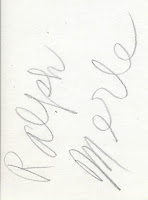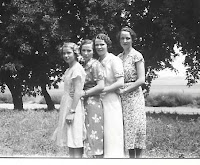| Ancestors on the Wall |
The series of blogs regarding old photographs that I have posted in recent weeks has been extremely popular, and people who follow my blog have left comments (don't forget to read the comments at the bottom of the blogs), have posted comments on face book, have sent e-mails, and have spoken directly with me. I love the comment that encouraged me not to stop "nagging" about the importance of labeling photographs! We had out-of-town visitors this weekend that even brought a few old photographs to share, but I could offer no help in identifying them.
I want to share two delightful e-mails that I received, because I am sure you will enjoy them.
C.W. wrote: "I have thoroughly enjoyed these last few blogs. We too have a box of photos not labeled... I am trying to go through ours and label as best I can. We did receive some pieces of furniture when Mom passed away. I want to put a picture and the name of who it belonged to on the back so our children will know that it is a family treasure. ...Fortunately we have a granddaughter with a lot of interest [in family history]. She did a really wonderful school project... I think she will carry on [the family history] for us. Take care and keep blogging."
Her idea of a photo attached to family antiques is a great one! Although my blogs have related to photographs, this is a wonderful suggestion for labeling furniture and other family objects. My mother-in-law was good to tape little stories on objects or put the story inside vases or boxes.
M.H. wrote: "Lyn, this was a very interesting and informative blog regarding old photographs... About 10 years ago, I was given a box of old photographs that were mostly not labeled. They had belonged to my Great grandmother's 2nd husband, and were all of his family. We had no idea of who his descendants might be. My grandmother saved them for years and then my aunt inherited them... She didn't want to keep them, but it was completely against our nature to discard any old photographs.
I finally suggested that since the Martins were from Larned that we donate them to the Santa Fe Trail Center if they would want them. They took them and advised me that they would be labeled as Martin family photos, but that they might also be used in exhibits and presentations about other aspects of the photos, such as fashion, hair styles, furniture and other props, etc. I thought that was a great idea. We were very glad to have found a good home for the photos. The moral of the story, as is one of the morals of your story, is: never throw away old photos."
His thoughtful decision to donate the old photographs to a museum in the community where the family lived is a wonderful suggestion, increasing the possibility that a descendant might happen upon the family images. Even if that does not happen, the family photographs will help preserve the history of that community.
Thanks to all of you who have shared your stories. I have certainly learned how many of you have old photographs you are trying to preserve and identify, and several of you have used family gatherings as opportunities to work together in that effort! The kind and encouraging words you send let me know what blogs you enjoy and keep me motivated to eventually get back to revisions of the manuscript telling Isaac's story and the story of the Populist movement in the late 1800s.
Because I have posted these interim blogs during the week, I will not be posting on Thursday this week as I usually do. The following week I will get back to my usual weekly Thursday posting, but it has been fun to hear from so many of you and to share your own stories about old photographs on this blog!
("Ancestors on the Wall" posted at the start of this blog is the display of framed photographs of those couples who have made my ancestral home their full-time residence. We now display those images on the wall of the renovated family home (as well as another display of other descendants who have lived at the farm). My great grandparents may not have occupied the house as a couple, but my great grandmother was certainly the first generation to live in the house. The grandparents and parents are shown in wedding photographs, including my husband and myself at the bottom of the display. We are the fourth generation to call it home, but descendants of these couples have been raised in the house and their descendants have visited and/or lived in the house as well. If a wedding photograph of my great grandparents exists, I am not aware of it.)

















